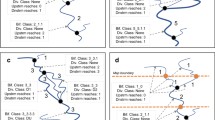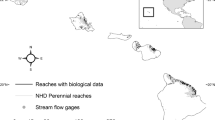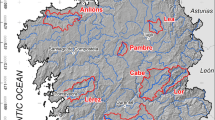Abstract
We present a spatially hierarchical, hydrogeomorphological stream classification, based on data collected in Ireland and reflecting our hypothesis that local (site scale) stream physical habitat characteristics are related to the physical properties of the extended reach within which a site is located, and, in turn, to the physical character of the catchment. Using a top-down approach, data on catchment, reach and site-scale stream physical properties were collected for 42 Irish headwater streams. The summary catchment properties (rock type, topography, soil type and hydrology) were extracted from secondary sources. Reach-scale physical controls on stream hydrogeomorphology (planform, gradient, degree of confinement, bed material) were assembled mainly from secondary sources. Site-scale information on the stream physical habitat mosaic was collected by field survey. Data analysis identified six new ‘River Types’ for steep mountain streams that extend a pre-existing classification system developed for English streams and rivers. Five of the new types with sufficient replication were associated with ‘indicator’ habitats and characteristic habitat assemblages. The classification method is simple to apply and so it is suitable for operational use. We believe that it is applicable beyond Ireland and England to other areas of northern and western Europe with similar climate−landscape conditions.









Similar content being viewed by others
Data availability
The data generated and analysed in this publication are available from the corresponding author upon reasonable request.
References
Addinsoft. 2021. XLSTAT Statistical and Data Analysis Solution. https://www.xlstat.com
Beisel, J. N., P. Usseglio-Polatera, S. Thomas & J. C. Moreteau, 1998. Stream community structure in relation to spatial variation: the influence of mesohabitat characteristics. Hydrobiologia 389: 73–88. https://doi.org/10.1023/A:1003519429979.
Beisel, J. N., P. Usseglio-Polatera & J. C. Moreteau, 2000. The spatial heterogeneity of a river bottom: a key factor determining macroinvertebrate communities, In: Jungwirth, M., S. Muhar, S. Schmutz (eds), Assessing the Ecological Integrity of Running Waters. Springer Netherlands, Dordrecht, pp. 163–171. https://doi.org/10.1007/978-94-011-4164-2_13.
Belletti, B., M. Rinaldi, A. D. Buijse, A. M. Gurnell & E. Mosselman, 2015. A review of assessment methods for river hydromorphology. Environmental Earth Sciences 73: 2079–2100. https://doi.org/10.1007/s12665-014-3558-1.
Belletti, B., M. Rinaldi, M. Bussettini, F. Comiti, A. M. Gurnell, L. Mao, L. Nardi & P. Vezza, 2017. Characterising physical habitats and fluvial hydromorphology: A new system for the survey and classification of river geomorphic units. Geomorphology 283: 143–157. https://doi.org/10.1016/j.geomorph.2017.01.032.
Boardman, J., K. Vandaele, R. Evans & I. D. L. Foster, 2019. Off-site impacts of soil erosion and runoff: Why connectivity is more important than erosion rates. Soil Use and Management 35: 245–256. https://doi.org/10.1111/sum.12496.
Brierley, G. J. & K. A. Fryirs, 2005. Geomorphology and river management: applications of the River Styles Framework. Blackwell. https://doi.org/10.1002/9780470751367.
Brookes, A., 1988. Channelized rivers: perspectives for environmental management, Wiley, Chichester:, 326.
Brown, A. G., L. Lespez, D. A. Sear, J. J. Macaire, P. Houben, K. Klimek, R. E. Brazier, K. Van Oost & B. Pears, 2018. Natural vs anthropogenic streams in Europe: History, ecology and implications for restoration, river-rewilding and riverine ecosystem services. Earth Science Reviews 180: 185–205. https://doi.org/10.1016/j.earscirev.2018.02.001.
Buffington, J. M. & D. R. Montgomery, 2021. Geomorphic classification of rivers: an updated review. Reference Module in Earth Systems and Environmental Sciences, Elsevier. https://doi.org/10.1016/B978-0-12-818234-5.00077-8.
Castro, J. M. & C. R. Thorne, 2019. The stream evolution triangle: Integrating geology, hydrology, and biology. River Research and Applications 35: 315–326. https://doi.org/10.1002/rra.3421.
Church, M., 1992. Channel morphology and typology. In Calow, P. & G. E. Petts (eds), The Rivers Handbook Blackwell, London (UK): 126–143.
Church, M., 2006. Bed material transport and the morphology of alluvial river channels. Annual Review of Earth and Planetary Sciences 34: 325–354. https://doi.org/10.1146/annurev.earth.33.092203.122721.
Downs, P. W. & K. J. Gregory, 2004. River channel management: towards sustainable catchment hydrosystems, Arnold, London:, 395.
Downs, P. W. & H. Piégay, 2019. Catchment-scale cumulative impact of human activities on river channels in the late Anthropocene: Implications, limitations, prospect. Geomorphology 338: 88–104. https://doi.org/10.1016/j.geomorph.2019.03.021.
EPA, 2017. River Network Routes, Irish Environmental Protection Agency.
EPA, 2018. WFD Significant Pressures dataset. Irish Environmental Protection Agency.
EPA, 2019. Soils Wet/Dry National. Irish Environmental Protection Agency.
Esri, 2019. ArcMap. https://www.esri.com
Frissell, C. A., W. J. Liss, C. E. Warren & M. D. Hurley, 1986. A hierarchical framework for stream habitat classification: Viewing streams in a watershed context. Environmental Management 10: 199–214. https://doi.org/10.1007/BF01867358.
Fryirs, K. & G. Brierley, 2021. Assemblages of geomorphic units: A building block approach to analysis and interpretation of river character, behaviour, condition and recovery. Earth Surface Processes and Landforms, Early View. https://doi.org/10.1002/esp.5264.
GSI, 2006. Hydrostratigraphic Rock Unit Groups. Geological Survey Ireland.
GSI, 2018. Physiographic Units Level 3. Geological Survey Ireland.
GSI, 2019. Groundwater Karst Features. Geological Survey Ireland.
Gurnell, A. M., W. Bertoldi & D. Corenblit, 2012. Changing river channels: the roles of hydrological processes, plants and pioneer landforms in humid temperate, mixed load, gravel bed rivers. Earth Science Reviews 111: 129–141. https://doi.org/10.1016/j.earscirev.2011.11.005.
Gurnell, A. M., D. Corenblit, D. García de Jalón, M. González del Tánago, R. C. Grabowski, M. T. O’Hare & M. Szewczyk, 2016a. A Conceptual Model of Vegetation–hydrogeomorphology Interactions Within River Corridors. River Research and Applications 32: 142–163. https://doi.org/10.1002/rra.2928.
Gurnell, A. M., M. Rinaldi, B. Belletti, S. Bizzi, B. Blamauer, G. Braca, T. Buijse, M. Bussettini, B. Camenen, F. Comiti, L. Demarchi, D. García de Jalón, M. González del Tánago, R. C. Grabowski, I. D. M. Gunn, H. Habersack, D. Hendriks, A. J. Henshaw, M. Klösch, B. Lastoria, A. Latapie, P. Marcinkowski, V. Martínez-Fernández, E. Mosselman, J. O. Mountford, L. Nardi, T. Okruszko, M. T. O’Hare, M. Palma, C. Percopo, N. Surian, W. van de Bund, C. Weissteiner & L. Ziliani, 2016b. A multi-scale hierarchical framework for developing understanding of river behaviour to support river management. Aquatic Sciences 78: 1–16. https://doi.org/10.1007/s00027-015-0424-5.
Gurnell, A. M., J. England, L. Shuker & G. Wharton, 2019. The contribution of citizen science volunteers to river monitoring and management: International and national perspectives and the example of the MoRPh survey. River Research and Applications 35: 1359–1373. https://doi.org/10.1002/rra.3483.
Gurnell, A. M., S. J. Scott, J. England, D. Gurnell, R. Jeffries, L. Shuker & G. Wharton, 2020. Assessing river condition: A multiscale approach designed for operational application in the context of biodiversity net gain. River Research and Applications 36: 1559–1578. https://doi.org/10.1002/rra.3673.
Joliffe, I. T. & J. Cadima, 2016. Principal Components Analysis: a review and recent developments. Philisophical Transactions of the Royal Society Series A. https://doi.org/10.1098/rsta.2015.0202.
Kondolf, G. M., H. Piégay, L. Schmitt & D.R. Montgomery, 2016. Geomorphic classification of rivers and streams. In: Kondolf, G.M. & H. Piégay (eds) Tools in Fluvial Geomorphology, pp. 133–158. https://doi.org/10.1002/9781118648551.ch7.
Leopold, L. B. & M. G. Wolman, 1957. River channel patterns: braided, meandering, and straight. United States Geological Survey Professional Paper. https://doi.org/10.3133/pp282B.
Montgomery, D. R., 1999. Process domains and the river continuum. Journal of the American Water Resources Association 35: 397–410. https://doi.org/10.1111/j.1752-1688.1999.tb03598.x.
Montgomery, D. R. & J. M. Buffington, 1997. Channel reach morphology in mountain drainage basins. Geological Society of America Bulletin 109: 596–611. https://doi.org/10.1130/0016-7606(1997)109%3c0596:CRMIMD%3e2.3.CO;2.
Montgomery, D. R. & J. M. Buffington, 1998. Channel processes, classification and response potential. In Naiman, R. J. & R. E. Bilby (eds), River ecology and management Springer-Verlag Inc., New York: 13–42.
Montgomery, D. R. & L. H. MacDonald, 2002. Diagnostic approach to stream channel assessment and monitoring. Journal of the American Water Resources Association 38: 1–16. https://doi.org/10.1111/j.1752-1688.2002.tb01530.x.
OPW, 2004. Arterial Drainage Scheme Channels. Office of Public Works.
Panks, S., N. White, A. Newsome, J. Potter, M. Heydon, E. Mayhew, M. Alvarez, T. Russell, S. J. Scott, M. Heaver, S. H. Scott, J. Treweek, B. Butcher & D. Stone, 2021. The biodiversity metric 3.0: Auditing and accounting for biodiversity value. User guide (Beta Version, July 2019). Natural England.
Petts, G. E. & A. M. Gurnell, 2021. Hydrogeomorphic Effects of Reservoirs, Dams, and Diversions. Reference Module in Earth Systems and Environmental Sciences, Elsevier. https://doi.org/10.1016/B978-0-12-374739-6.00345-6.
Rinaldi, M., N. Surian, F. Comiti & M. Bussettini, 2013. A method for the assessment and analysis of the hydromorphological condition of Italian streams: The Morphological Quality Index (MQI). Geomorphology 180–181: 96–108. https://doi.org/10.1016/j.geomorph.2012.09.009.
Rinaldi, M., A. M. Gurnell, M. G. del Tánago, M. Bussettini & D. Hendriks, 2016. Classification of river morphology and hydrology to support management and restoration. Aquatic Sciences 78: 17–33. https://doi.org/10.1007/s00027-015-0438-z.
Schumm, S. A., 1977. The fluvial system, Wiley, New York:, 338.
Schumm, S. A., 1985. Patterns of alluvial rivers. Annual Review of Earth and Planetary Science 13: 5–27. https://doi.org/10.1146/annurev.ea.13.050185.000253.
Simon, A., S. J. Bennett & J. M. Castro (eds), 2011. Stream restoration in dynamic fluvial systems: scientific approaches, analyses, and tools. Geophysical Monograph 194, American Geophysical Union, Washington DC. https://doi.org/10.1029/GM194
Wolter, C., A. D. Buijse & P. Parasiewicz, 2016. Temporal and Spatial Patterns of Fish Response to Hydromorphological Processes: Fishes Response to Hydromorphology. River Research and Applications. 32: 190–201. https://doi.org/10.1002/rra.2980.
Acknowledgements
This research is funded as part of the Irish Environmental Protection Agency Research Programme 2014-2020 (contract 2017-W-LS-14). The programme is financed by the Irish Government. It is administered on behalf of the Department of Communications, Climate Action and the Environment by the EPA, which has the statutory function of co-ordinating and promoting environmental research.
Funding
The funded was provided by Irish Environmental Protection Agency (Grant No. 2017-W-LS-14).
Author information
Authors and Affiliations
Corresponding author
Ethics declarations
Conflict of interest
The authors have no competing interest to declare that are relevant to the content of this article.
Additional information
Handling editor: Sidinei M. Thomaz
Publisher's Note
Springer Nature remains neutral with regard to jurisdictional claims in published maps and institutional affiliations.
Guest editors: Mary Kelly-Quinn, Jeremy Biggs, J. Iwan Jones & William D. Riley / Small Waterbodies in the Landscape
Supplementary Information
Below is the link to the electronic supplementary material.
Rights and permissions
Springer Nature or its licensor (e.g. a society or other partner) holds exclusive rights to this article under a publishing agreement with the author(s) or other rightsholder(s); author self-archiving of the accepted manuscript version of this article is solely governed by the terms of such publishing agreement and applicable law.
About this article
Cite this article
Cox, E.J., Gurnell, A.M., Bowes, M.J. et al. A multi-scale analysis and classification of the hydrogeomorphological characteristics of Irish headwater streams. Hydrobiologia 850, 3391–3418 (2023). https://doi.org/10.1007/s10750-022-05013-5
Received:
Revised:
Accepted:
Published:
Issue Date:
DOI: https://doi.org/10.1007/s10750-022-05013-5




